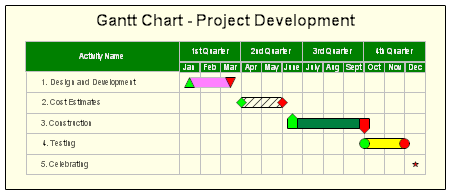Five Steps to Work with Gantt Charts
 A major challenge on projects is that you make sure you have a robust, detailed project schedule. A schedule helps you see how long the project will take and how much effort needs to go into it. If you get it wrong it can be a costly and time-consuming mistake.
A major challenge on projects is that you make sure you have a robust, detailed project schedule. A schedule helps you see how long the project will take and how much effort needs to go into it. If you get it wrong it can be a costly and time-consuming mistake.
Gantt charts are a great tool to display your project schedule in a way that makes it easy to see what needs to be done on the project. So here are 5 steps to working with Gantt charts.
Step 1: Create your task list
First, you need to know what tasks there are to work on! Brainstorm with your team and come up with a complete list of tasks required for the project. Make it as comprehensive as you can. It can help to do this over a couple of days so that you have time to reflect on what really needs to be done.
Step 2: Link tasks together
Some tasks need to be done in a particular order. Gantt charts show you the dependencies (links) between tasks. If a task has to start after, before or at the same time as another one, you can add these links into your project schedule. Then those tasks will always be linked together.
Step 3: Set start and end dates for tasks
Linking tasks is the first step to creating a timeline, but you will probably have to schedule some start and end dates manually. Go through the list of tasks that you have created and set dates for your activities. These will depend on how long each task will take. The bars on the Gantt chart will change length to represent how long each task is.
Step 4: Add some milestones
A milestone is a point on the project which marks an achievement. It is normally shown on a Gantt chart as a diamond, and it represents a task with a duration of zero days. You can link tasks to milestones. Milestones can mark the end of a phase, the completion of a big task or series of tasks or the start of a new stage. Aim to schedule milestones regularly throughout your project plan as they will help you track if you are on schedule.
Step 5: Add resources to tasks
You may have to change some of the project dates if you find that someone on the team has too much to do. They won’t be able to work on dozens of tasks all at the same time, so adjust your schedule as you need to. Software can help you do this which takes the time-consuming analysis out of calculating what you need to amend. You can display the names of team members working on tasks directly on the Gantt chart too.
The Gantt chart features enable you to easily create beautiful Gantt charts. You can see progress at a glance and share the status with your colleagues.


